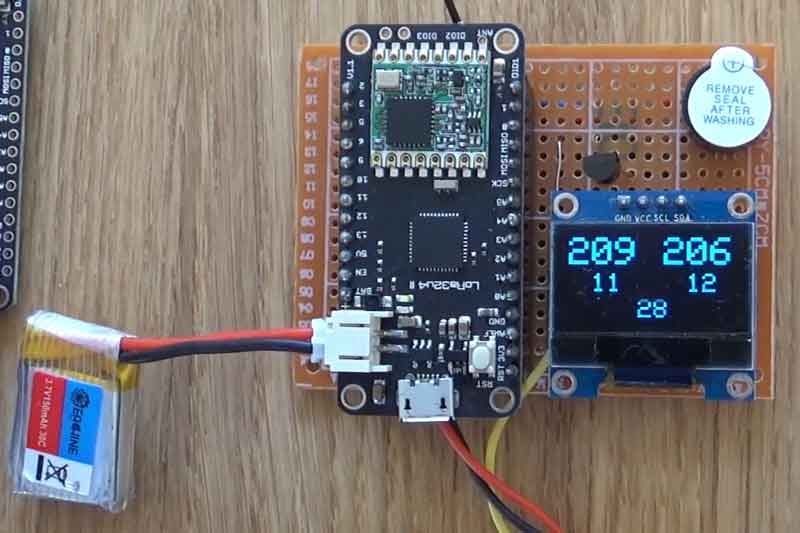LoRa has been making quite a stir in hacker circles over the past couple of years, as it offers a fascinating combination of long range, low power, and low cost. It does this by using spread spectrum techniques on unlicensed frequency bands, meaning it can send data a surprising distance and that you don’t need a radio license to use it. It is mainly used for Internet of Things things, but [Paweł Spychalski] has other ideas: he’s building a system to use it to control a quadcopter drone over distances of 5 kilometers or more. That’s an ambitious aim, considering that the parts he is using cost only a few bucks.
He’s using an off-brand Adafruit Feather LoRa board and a couple of home-made antennas with his own software that takes the data from the Taranis control port of the RC controller, encodes it and chirps it out over the LoRa radio. At the other end, a similar radio receives and decodes the data, feeding it out to the drone.
This is definitely still a work in progress, but he has got it working, flying his drone over the link, keeping control of it out to several hundred meters. At the moment, he can’t go much further as it seems that his LoRa radio is being overwhelmed by the video link on the drone, but he is working on changing the frequency spread & hopping and using a better antenna to provide longer range. We’ve seen some interesting stuff from [Pawel] before, like his DIY telemetry system, so this project is worth keeping an eye on if you are a drone fan.
https://www.youtube.com/watch?v=Q1DytEuOXJs

















Hacking’s nice, but LoRa seems to be a niche in the consumer and business market. Even ZigBee seems to be wider spread, especially in some power meters.
6LoWPAN is getting a bit of mileage too.
It’s still very new, but definitely great technology. A lot of countries have full-coverage access networks now, waiting to be used.
Lora has some restricitons for sending data (messages). There are duty cycle so you are limit to roughly 24 messages or 30 sec of airtime, this depends which transmission mode you are using and of course in which country you are living.
You’re getting mixed up with LoRaWAN, which sits on top of LoRa. Use a bare LoRa radio and you can send and receive as much as you want.
LoRa is the rf communication protocol basically the modulation technique, LoRaWAN is the network of LoRa Gateways and node that has lot of rules and stuff
I have a little kit: “Slice of Radio” SRF from “Wireless Things”/Ciseco -Yes I spelled that right, because it’s the UK company that went out of business, not the giant networking corp. It uses a 868MHz signal, apparently with options for 433 and 915MHz. I think we can have a little more confidence in the staying power of the Adafruit Feather line (although what’s this about using an off-brand?) But it seems to me that with LoRa, the hacker community is here stretching the limits of what is viable in the long term. I want to see a “killer app” for LoRa. Something that reassures me I’ll be able to expand or upgrade my LoRa network in five years. Is drone control gonna be that app? IDK
I have a neat little Arduino kit using 868MHz from “Wireless Things”/Cisesco. I didn’t misspell that, because it’s the UK company that went out of business, not the networking giant. I think we can expect more longevity from Adafruit (but what’s this about using an off-brand?) I’m not convinced that LoRa has a solid future. Am I going to be able to expand or upgrade my LoRa network in five years? Is drone control going to be the “killer app” that solidifies LoRa’s place in tech? The jury is still out.
Author , Why is this so ambitious? There are already 2 such commercial RC systems on the market which are Lora based, and on the same silicon. The TBS Crossfire, and the FrSky R9. However, the Crossfire does have some issues, and its yet to be seen how the R9 will fare. However, they are both working systems that have been in use for a bit. This guy has just simply stated out to copy the Crossfire essentially. Which is great…..give us some firmware that fixes its issues.
A few things have been confused here I think.
For one thing, there is no way you can send video via LoRa. The bandwidth can’t support the data rate. If he is getting video then the LoRa radio is not operating in LoRa mode. Some radios can have LoRa turned off and operate with FSK modulation which could possibly support a video stream but then you would have very limited range.
LoRa is designed to sacrifice data rate to achieve long distance. For a drone, the only way to control it out of sight would be with GPS feedback. You would need to recieve the GPS coordinates, altitude, direction, speed into a phone or tablet to plot the position. For video, you would need to save to flash drive and watch it after the drone returned.
Also, I have no idea what country this originated in but many do not permit flying a drone out of sight of the operator. If the drone crashed and damaged something, you would be liable for fines and litigation!
Hi, Elliot-from-the-future here. Pavel’s project kinda foundered, but it inspired ExpressLRS, which has gotten some industry support in 2021, and will probably take over the world in 2022.
https://www.expresslrs.org/2.0/
So it wasn’t a bad idea at all!